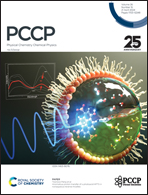Intramolecular boron-locking strategy induced remarkable first hyperpolarizability: role of torsion angles between donor and acceptor units†
Abstract
In conventional strategies to design donor–acceptor (D–A) organic molecules with a large electronic contribution to the first hyperpolarizability (β), the effects of the torsion angles (θ1 and θ2) between donor and acceptor moieties are barely considered. To address this issue, in this work, a promising and novel intramolecular boron-locking strategy combined with the different locking groups of different acceptors to control θ1 and θ2, has been proposed to make D–A organic molecules with large β values. Intriguingly, reducing the torsion angles will make the β value of the pyridiny thiophene triphenylamine unit (Py-Th-TPA) dramatically increase up to 94%, which is mainly ascribed to the smaller θ1 and θ2 leading to lower excited energy of the crucial excited state, and enhanced charge transfer (CT) from TPA to Py-Th moieties, and finally greatly increase the donor and acceptor part contributions to β. Correlation between the difference, |θ1 − θ2| and β, provides a large coefficient of determination, R2 = 0.78, which demonstrates that |θ1 − θ2| can be regarded as a potential descriptor for designing nonlinear optics (NLO) materials with D–A architecture. Clearly, we uncovered that θ1 and θ2 play a crucial role in the performance of NLO materials with D–A fragments.



 Please wait while we load your content...
Please wait while we load your content...